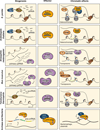Dogma derailed: the many influences of RNA on the genome
- PMID: 23473599
- PMCID: PMC3825098
- DOI: 10.1016/j.molcel.2013.02.010
Dogma derailed: the many influences of RNA on the genome
Abstract
Epigenetic control of gene expression is a critical component of transcriptional regulation. Remarkably, the deposition of epigenetic modifications is often guided by noncoding RNAs. Although noncoding RNAs have been most often implicated in posttranscriptional gene silencing, these molecules are now emerging as critical regulators of gene expression and genomic stability at the transcriptional level. Here, we review recent efforts to understand the mechanisms by which RNA controls the expression or content of DNA. We discuss the role of both small RNAs and long noncoding RNAs in directing chromatin changes through histone modifications and DNA methylation. Furthermore, we highlight the function of RNA in mediating DNA cleavage during genome rearrangements and pathogen defense. In understanding the mechanisms of RNA control over DNA, the power of RNA may one day be harnessed to impact gene expression in a therapeutic setting.
Copyright © 2013 Elsevier Inc. All rights reserved.
Figures



References
-
- Andersson AF, Banfield JF. Virus population dynamics and acquired virus resistance in natural microbial communities. Science. 2008;320:1047–1050. - PubMed
-
- Aravin AA, Hannon GJ, Brennecke J. The Piwi-piRNA pathway provides an adaptive defense in the transposon arms race. Science. 2007a;318:761–764. - PubMed
-
- Aravin AA, Sachidanandam R, Girard A, Fejes-Toth K, Hannon GJ. Developmentally regulated piRNA clusters implicate MILI in transposon control. Science. 2007b;316:744–747. - PubMed
-
- Barrangou R, Fremaux C, Deveau H, Richards M, Boyaval P, Moineau S, Romero DA, Horvath P. CRISPR provides acquired resistance against viruses in prokaryotes. Science. 2007;315:1709–1712. - PubMed
Publication types
MeSH terms
Substances
Grants and funding
LinkOut - more resources
Full Text Sources
Other Literature Sources

